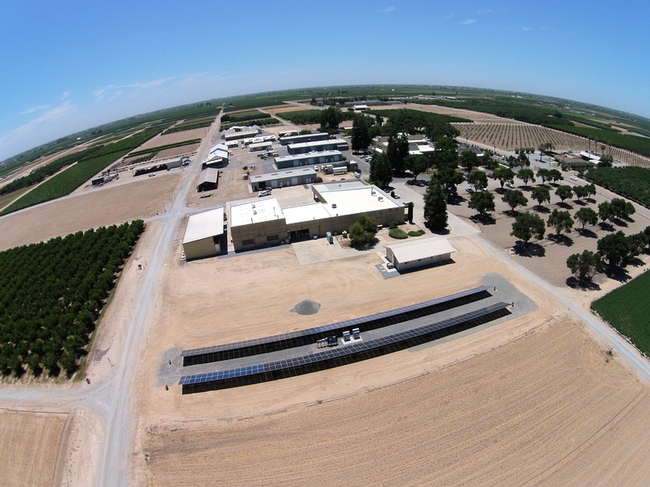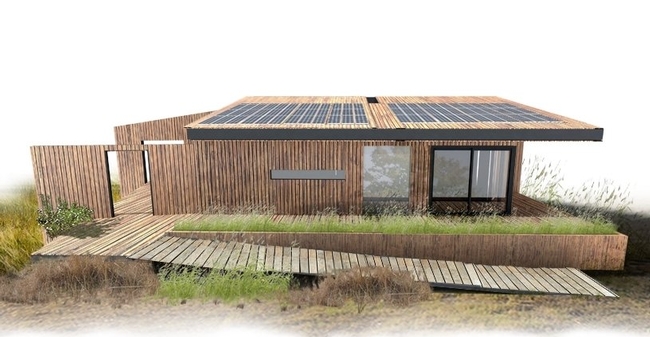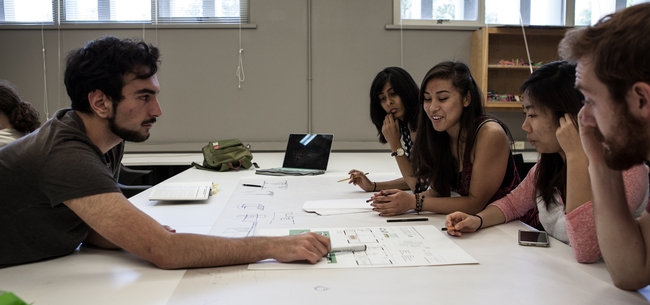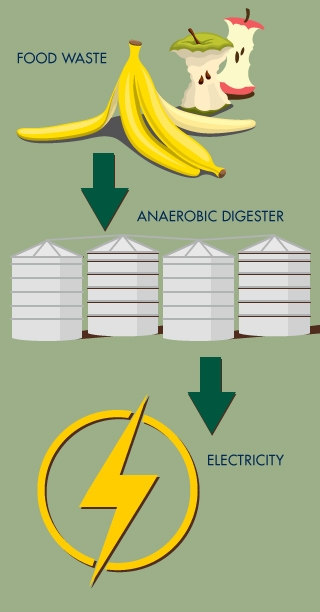Posts Tagged: energy
Pollinator Habitat: Important Part of Solar Energy Study
Solar energy should not only be used to benefit global sustainability, but to protect our global ecological systems, including climate, air quality,...
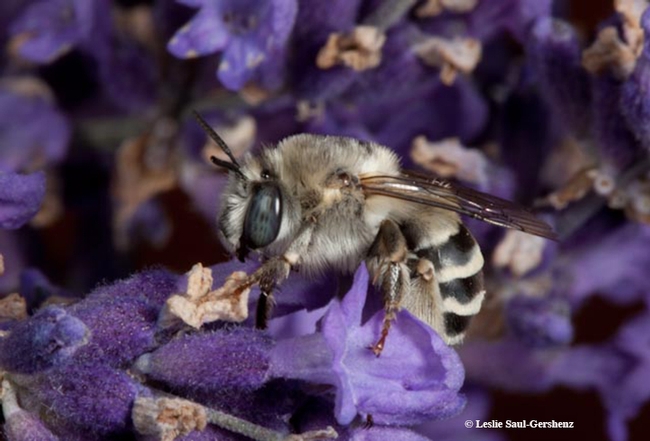
Solar energy can be used to protect pollinator habitat, according to a research paper published July 9 in the journal Nature. This is Anthophora urbana, a ground-nesting solitary bee which has a broad distribution including the Mojave Desert. It is a floral generalist collecting pollen and nectar from many species of plants, says UC Davis entomologist Leslie Saul-Gershenz. (Photo by Leslie Saul-Gershenz)
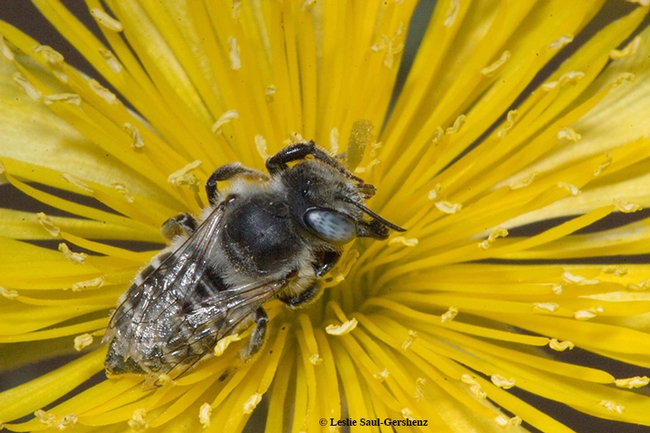
Native bee Megachile sp. on Mentzelia flower in the Mojave Desert. (Photo by Leslie Saul-Gershenz)
Why Silver Digger Bees Are Like Gold
Why silver digger bees are like gold... Remember those "long lost" silver digger bees found last week at the San Francisco Presidio? They hadn't...
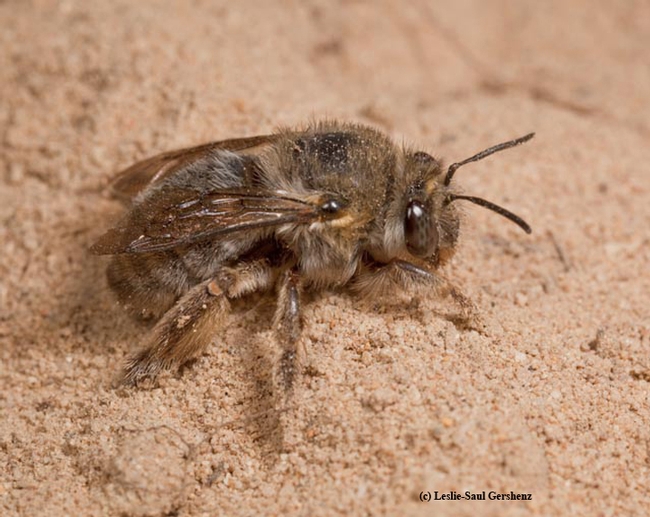
Close-up of female silver digger bee, Habropoda miserabilis, taken at Waldport, Ore. in 2015. (Copyrighted Photo by Leslie Saul-Gershenz. Used with Permission)
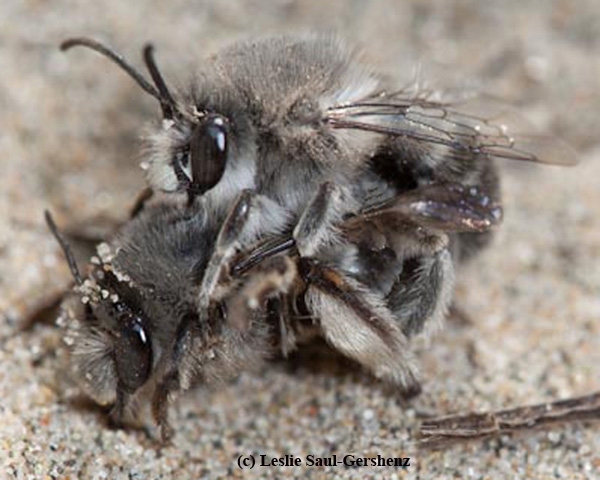
Habropoda miserabilis male and female—the male is mate-guarding the female after mating with her, preventing her from mating with other males. (Copyrighted photo by Leslie Saul-Gershenz. Used with permission)
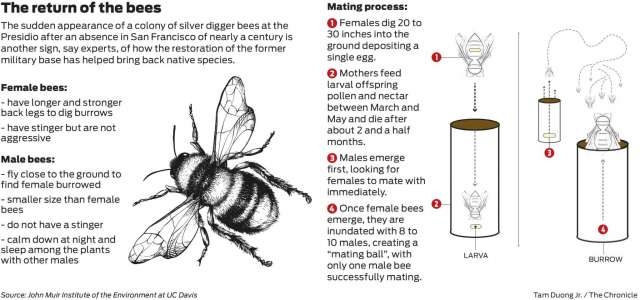
This graphic, the work of Leslie Saul-Gershenz, details information on the male and female of the species.
Phase 3 complete in Kearney solar energy project
JKB Energy has completed three phases of a solar energy project at UC ANR Kearney Agricultural Research and Extension (KARE) Center in Parlier. The system eliminates thousands of pounds of emissions and saves the center tens of thousands of dollars in energy costs annually, according to a JKB Energy news release. Kearney is one of nine research and extension centers located throughout the state that are part of the University of California Division of Agricultural and Natural Resources (UC ANR).
JKB Energy has worked with Robert Ray, superintendent of the UC ANR KARE physical plant, to maximize their bill offset program. Since 2012, when the program started, UC ANR KARE has steadily cut its energy costs.
After the completion of the final phase, projected for 2016, the center's “postharvest” meter's annual electricity costs will be offset by approximately 96 percent. Postharvest research is science conducted after a crop has been harvested and includes such processes as of cooling, cleaning, sorting, and packaging and how these might affect the quality of stored fruits and vegetables.
According to JKB Energy, over 25 years, this project will eliminate the equivalent of:
- 473,735 pounds of carbon dioxide, the leading greenhouse gas
- 1,520 pounds of nitrogen dioxide, which creates smog
- 1,376 pounds of sulfur dioxide, which causes acid rain
- 94 pounds of particulates that cause asthma
- 770,814 miles driven in an average car
The system is the equivalent of taking 2.5 cars off the road for 25 years, or planting 4.1 acres of trees.
Students design a solar home for farmworkers
When a team of UC Davis students packs up its house and travels to Irvine next year for the U.S. Department of Energy's 2015 Solar Decathlon competition, its members will bring not only a desire to win, but also to make zero-net-energy homes more affordable.
After submitting an entry for the first time, UC Davis was one of 20 universities selected in February to compete in the Solar Decathlon. The competition draws students and scientists from universities across the nation — from Yale and Vanderbilt to CalPoly and Sacramento State — to design and build solar-powered homes that are energy efficient and attractive.
Meeting a competition milestone, UC Davis' team, Aggie Sol, submitted 80 percent-complete design documents to the department on Oct. 9. The UC Davis project is designed to be a marketable, sustainable house for farmworkers and other low-income communities. Complete plans for the home are due in January, when construction will begin at UC Davis. In October 2015, the home will be disassembled, packed in pieces and transported to the competition site in Irvine.
“I really want to see solar homes everywhere,” said Aggie Sol team member Payman Alemi, a civil and environmental engineering major. “I want every house to be solar powered, and I want every car to be electric. I want everything to be sustainable, and I think that developing a mass marketable house is a big stepping stone.”
Connecting a campus
In addition to addressing a social and environmental problem, the project also provides unique educational opportunities for undergraduate and graduate students.
It connects students in the fields of engineering, architecture, design, communication and development. They've drawn on the expertise and support of faculty in the colleges of Letters and Sciences, Engineering, and Agricultural and Environmental Sciences. They've also tapped the experience of several energy centers on campus—most located at West Village—including the Institute of Transportation Studies, Energy Efficiency Center, Plug-In Hybrid and Electric Vehicle Research Center, and Center for Water Energy Efficiency.
“I heard about what we were going to do about ZNE housing for low-income families, and that really struck a chord with me, being from a low-income neighborhood,” said team member Alejandro Perez, a civil and environmental engineering major. “I really want to make my own house energy efficient, but it's really costly, and it's not really practical where I'm from. Just being part of that effort to make it more affordable really inspired me to be part of the team.”
And while team Aggie Sol is made of about 20 students, an estimated 200 to 500 students from various disciplines will study the project in the coming months, including students from UC Davis Extension, the continuing education division of UC Davis.
The project students are also working with the UC Davis Graduate School of Management and the Division of Social Sciences to create a business plan for the home.
“We want to use this as a way to showcase the ability for zero net energy to be affordable and to do it with a business model in place to implement change in California,” said faculty adviser Frank Loge, a professor of civil and environmental engineering. “If we don't win the competition and still market it, some of us will feel like this has been a very successful effort.”
Nothing but net
UC Davis has proven itself a national leader in zero-net-energy design. In 2011, it opened West Village, a public-private partnership with West Village Community Partnership LLC and the nation's largest planned zero-net-energy community. This past spring, it debuted the Honda Smart Home, which produces enough renewable energy to power both the home and a Honda Fit electric vehicle in its garage.
Private builders and homeowners worldwide have also taken on the challenge of creating homes that produce as much energy as they consume, and the California Public Utilities Commission has a goal for all new residential homes to be zero net energy by 2020. Yet such residences still tend to fall on the upper financial spectrum of the real est
ate market.
“As part of our effort at UC Davis, we want to make zero-net-energy housing affordable for everyone,” Loge said. “We're trying to drive down the price point of zero-net-energy housing to help the housing market understand that you can have affordable, nice homes that are zero net energy.”
Big cut in price
Price estimates for most homes that compete in the Decathlon range from $300 to $350 per square foot. Team Aggie Sol intends to cut that price by more than half, to $70 to $150 per square foot.
One way they're doing that is by creating a relatively simple, modular design using prefabricated materials. The Aggie Sol design also addresses the health and living concerns associated with farmworkers' current housing conditions, such as poor air quality, crowding and lack of shade.
The home combines public and private spaces in three linear zones: Two climate-controlled living spaces are separated by an enclosed deck. The zones act as climate buffers that maximize passive cooling in summer and passive heating in winter. It will also feature “smart home” technology that aligns the home's needs with the electrical grid, communicating with the resident and power provider to manage energy systems more effectively.
The team plans to begin building the house in January on the UC Davis campus but has not yet chosen a location. Loge said they intend for the home to be built in a public place.
The Department of Energy provided a $50,000 grant to Aggie Sol, while the team is attempting to raise at least another $700,000 for training, travel, equipment, uniforms and team-building costs.
Biodigester turns campus waste into campus energy
Last week, on Earth Day, the university and Sacramento-based technology partner CleanWorld unveiled the UC Davis Renewable Energy Anaerobic Digester (READ) at the campus' former landfill. Here, the anaerobic digestion technology Zhang invented is being used inside large, white, oxygen-deprived tanks. Bacterial microbes in the tanks feast on campus and community food and yard waste, converting it into clean energy that feeds the campus electrical grid.
“This technology can change the way we manage our solid waste,” Zhang said. “It will allow us to be more economically and environmentally sustainable."
It is the third commercial biodigester CleanWorld has opened using Zhang's technology within the past two years and is the nation's largest anaerobic biodigester on a college campus.
The system is designed to convert 50 tons of organic waste to 12,000 kWh of renewable electricity each day using state-of-the-art generators, diverting 20,000 tons of waste from local landfills each year. It is expected to reduce greenhouse gas emissions by 13,500 tons per year.
The READ BioDigester encompasses several of the university's goals: reducing campus waste in a way that makes both economic and environmental sense, generating renewable energy, and transferring technology developed at UC Davis to the commercial marketplace.
The biodigester will enable the more than 100 million tons of organic waste each year that is currently being landfilled in the U.S. to be converted to clean energy and soil products. The READ BioDigester is a closed loop system, moving from farm to fork to fuel and back to farm. Whatever is not turned into biogas to generate renewable electricity can be used as fertilizer and soil amendments — 4 million gallons of it per year, which could provide natural fertilizers for an estimated 145 acres of farmlands each day.
Nearly half of the organic waste, or feedstock, needed to operate the biodigester to full benefit will come from UC Davis dining halls, animal facilities and grounds. CleanWorld is working with area food processing and distribution centers to supply the remaining amount. Meanwhile, UC Davis will earn 100 percent of the project's green energy and carbon credits and receive all of the electricity generated.
Anaerobic digestion is an age-old process. However, Zhang's patented technology made it more efficient — capable of eating a broader variety and bigger quantity of waste, turning it into clean energy faster and more consistently than other commercial anaerobic biodigesters.
View a video about the UC David biodigester here:
(This blog post is condensed from a UC Davis news release about the biodigester.)
Additional information:
- Read the full press release
- Download biodigester photos
- Vine video: From lunch to lights
- Visit http://www.cleanworld.com/


